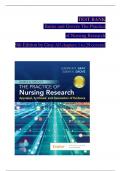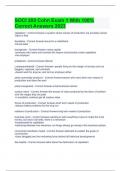TEST BANK
Burns and Groves The Practice
of Nursing Research
9th Edition by Gray All chapters 1 to 29 covered
,Unit One: Introduction to Nursing Research
KJ KJ KJ KJ KJ
1. Discovering the World of Nursing Research
KJ KJ KJ KJ KJ KJ
2. Evolution of Research in Building Evidence-Based Nursing Practice
KJ KJ KJ KJ KJ KJ KJ KJ
3. Introduction to Quantitative Research
KJ KJ KJ KJ
4. Introduction to Qualitative Research
KJ KJ KJ KJ
Unit Two: The Research Process
KJ KJ KJ KJ
5. Research Problem and Purpose
KJ KJ KJ KJ
6. Objectives, Questions, Variables, and Hypotheses
KJ KJ KJ KJ KJ
7. Review of Relevant Literature
KJ KJ KJ KJ
8. Frameworks
KJ
9. Ethics in Research
KJ KJ KJ
10. Quantitative Methodology: Noninterventional Designs and Methods
KJ KJ KJ KJ KJ KJ
11. Quantitative Methodology: Interventional Designs and Methods
KJ KJ KJ KJ KJ KJ
12. Qualitative Research Methods
KJ KJ KJ
13. Outcomes Research
KJ KJ
14. Mixed Methods Research
KJ KJ KJ
15. Sampling
KJ
16. Measurement Concepts
KJ KJ
17. Measurement Methods Used in Developing Evidence-Based Practice
KJ KJ KJ KJ KJ KJ KJ
Unit Three: Putting It All Together for Evidence-Based Health Care
KJ KJ KJ KJ KJ KJ KJ KJ KJ
18. Critical Appraisal of Nursing Studies
KJ KJ KJ KJ KJ
19. Evidence Synthesis and Strategies for Implementing Evidence-Based Practice
KJ KJ KJ KJ KJ KJ KJ KJ
Unit Four: Analyzing Data, Determining Outcomes, and Disseminating Research
KJ KJ KJ KJ KJ KJ KJ KJ
20. Collecting and Managing Data
KJ KJ KJ KJ
21. Introduction to Statistical Analysis
KJ KJ KJ KJ
22. Using Statistics to Describe Variables
KJ KJ KJ KJ KJ
23. Using Statistics to Examine Relationships
KJ KJ KJ KJ KJ
24. Using Statistics to Predict
KJ KJ KJ KJ
25 Using Statistics to Determine Differences
KJ KJ KJ KJ KJ
26. Interpreting Research Outcomes
KJ KJ KJ
27. Disseminating Research Findings
KJ KJ KJ
Unit Five: Proposing and Seeking Funding for Research
KJ KJ KJ KJ KJ KJ KJ
28. Writing Research Proposals
KJ KJ KJ
29. Seeking Funding for Research
KJ KJ KJ KJ
Chapter 1: Discovering the World of Nursing Researc
KJ KJ KJ KJ KJ KJ KJ
hTest Bank
JK KJ
MULTIPLE CHOICE KJ
1. Nurses with a bachelor’s degree in nursing can participate in the implementation of evidence
KJ KJ KJ KJ KJ KJ KJ KJ KJ KJ KJ KJ KJ
-based protocols in practice. This means that the BSN nurse
K
J KJ KJ KJ KJ KJ KJ KJ KJ KJ
a. Develops evidence-based guidelines KJ KJ
b. Designs research studies, on which protocols may be based
KJ KJ KJ KJ KJ KJ KJ KJ
c. Evaluates and revises evidence-based protocols KJ KJ KJ KJ
d. Contributes practice wisdom when applying protocols in patient settings KJ KJ KJ KJ KJ KJ KJ KJ
e. Mentors PhD researchers in the clinical setting during protocol development
KJ KJ KJ KJ KJ KJ KJ KJ KJ
ANS: D KJ
Nurses with a BSN degree have knowledge of the research process and skills in reading andc
KJ KJ KJ KJ KJ KJ KJ KJ KJ KJ KJ KJ KJ KJ KJ K
J
, ritically appraising studies. They assist with the implementation of evidence-
KJ KJ KJ KJ KJ KJ KJ KJ KJ
based guidelines, protocols, algorithms, and policies in practice. This implies that nurses pro
KJ KJ KJ KJ KJ KJ KJ KJ KJ KJ KJ KJ
vide their point of view, from the clinician’s vantage, when new protocols are being put into
KJ KJ KJ KJ KJ KJ KJ KJ KJ KJ KJ KJ KJ KJ KJ
practice, and continue to provide feedback, regarding the positive and negative aspects of t
KJ KJ KJ KJ KJ KJ KJ KJ KJ KJ KJ KJ KJ KJ
hose protocols. KJ
DIF: Cognitive Level: Analysis KJ KJ REF: Page 4 KJ KJ
2. Research is designed to test the idea of providing companion dogs to elders in a major hospit
KJ KJ KJ KJ KJ KJ KJ KJ KJ KJ KJ KJ KJ KJ KJ KJ
al, in order to determine the effect upon the elders’ level of orientation. (The dogs’ levelof ori
KJ KJ KJ KJ KJ KJ KJ KJ KJ KJ KJ KJ KJ KJ KJ K
J KJ
entation will not be a focus of the research.) This type of study can do which of the followin
KJ KJ KJ KJ KJ KJ KJ KJ KJ KJ KJ KJ KJ KJ KJ KJ KJ KJ
g?
a. Control
b. Describe
c. Explain
d. Predict
ANS: A KJ
Control is the ability to manipulate the situation to produce the desired outcome. Descriptio
KJ KJ KJ KJ KJ KJ KJ KJ KJ KJ KJ KJ KJ
ninvolves identifying and understanding the nature of nursing phenomena and, sometimes, th
K
J KJ KJ KJ KJ KJ KJ KJ KJ KJ KJ KJ
erelationships among them. Explanation clarifies the relationships among phenomena and id
K
J KJ KJ KJ KJ KJ KJ KJ KJ KJ KJ
entifies the reasons why certain events occur. The ability to estimate the probability of a spe
KJ KJ KJ KJ KJ KJ KJ KJ KJ KJ KJ KJ KJ KJ KJ
cific outcome in a given situation in nursing practice is known as prediction. The researcher
KJ KJ KJ KJ KJ KJ KJ KJ KJ KJ KJ KJ KJ KJ
’s focus is on predicting what is likely.
KJ KJ KJ KJ KJ KJ KJ
DIF: Cognitive Level: Application KJ KJ REF: Page 13KJ KJ
3. A researcher wants to find out whether children with autism who are hospitalized on a pedia
KJ KJ KJ KJ KJ KJ KJ KJ KJ KJ KJ KJ KJ KJ KJ
tric ward will require more hours of nursing care than average children when the parentsor ca
KJ KJ KJ KJ KJ KJ KJ KJ KJ KJ KJ KJ KJ KJ K
J KJ
regivers are not present. What type of research outcome does this provide?
KJ KJ KJ KJ KJ KJ KJ KJ KJ KJ KJ
a. Control
b. Description
c. Explantation
d. Prediction
, ANS: D KJ
Control is the ability to manipulate the situation to produce the desired outcome. Descriptio
KJ KJ KJ KJ KJ KJ KJ KJ KJ KJ KJ KJ KJ
ninvolves identifying and understanding the nature of nursing phenomena and, sometimes, th
K
J KJ KJ KJ KJ KJ KJ KJ KJ KJ KJ KJ
erelationships among them. Explanation clarifies the relationships among phenomena and id
K
J KJ KJ KJ KJ KJ KJ KJ KJ KJ KJ
entifies the reasons why certain events occur. The ability to estimate the probability of a spe
KJ KJ KJ KJ KJ KJ KJ KJ KJ KJ KJ KJ KJ KJ KJ
cific outcome in a given situation in nursing practice is known as prediction. The researcher
KJ KJ KJ KJ KJ KJ KJ KJ KJ KJ KJ KJ KJ KJ
’s focus is on predicting what is likely.
KJ KJ KJ KJ KJ KJ KJ
DIF: Cognitive Level: Application KJ KJ REF: Page 16 KJ KJ
4. A researcher who desires to determine the cause-and-
KJ KJ KJ KJ KJ KJ KJ
effect relationship between requiring that all children under the age of 8 will ride in special
KJ KJ KJ KJ KJ KJ KJ KJ KJ KJ KJ KJ KJ KJ KJ KJ
care harnesses and the subsequent rateof children’s spinal cord injury will consequently util
KJ KJ KJ KJ KJ K
J KJ KJ KJ KJ KJ KJ KJ
ize which form of nursing research?
KJ KJ KJ KJ KJ
a. Descriptive research KJ
b. Outcomes research KJ
c. Qualitative research KJ
d. Quantitative research KJ
ANS: D KJ
Quantitative research, the most frequently used method, is a formal, objective, systematic m
KJ KJ KJ KJ KJ KJ KJ KJ KJ KJ KJ KJ
ethodology to describe variables, test relationships, and examine cause-and-
KJ KJ KJ KJ KJ KJ KJ KJ
effect interactions. Quantitative research includes experimental research, which is the metho
KJ KJ KJ KJ KJ KJ KJ KJ KJ KJ
d for testing cause-and-
KJ KJ KJ
effect relationships between and among specific variables. Qualitative research methods are
KJ KJ KJ KJ KJ KJ KJ KJ KJ KJ KJ
used for explaining meanings and describing experiences in context. Descriptive research in
KJ KJ KJ KJ KJ KJ KJ KJ KJ KJ KJ
volves identifying and understanding the nature of phenomena and, sometimes, the relations
KJ KJ KJ KJ KJ KJ KJ KJ KJ KJ KJ
hips among them. Outcomes research examines the end result of carein huge populations, m
KJ KJ KJ KJ KJ KJ KJ KJ KJ KJ K
J KJ KJ KJ
ost often retrospectively, using a database.
KJ KJ KJ KJ KJ
DIF: Cognitive Level: Application KJ KJ REF: Page 3 KJ KJ
5. Despite the presence of an intraventricular drain, the intracranial pressure of an ICU neuro pa
KJ KJ KJ KJ KJ KJ KJ KJ KJ KJ KJ KJ KJ KJ
tient remains increased. The nurse recalibrates the machine, makes sure the monitor is on the
KJ KJ KJ KJ KJ KJ KJ KJ KJ KJ KJ KJ KJ KJ K
same level as the drain, checks all connections, and then notifies the physician, who comesto
J KJ KJ KJ KJ KJ KJ KJ KJ KJ KJ KJ KJ KJ KJ K
J KJ
the unit and inserts a new drain. What type of reasoning prompts the nurse to recalibrate, ens
KJ KJ KJ KJ KJ KJ KJ KJ KJ KJ KJ KJ KJ KJ KJ KJ
ure proper placement, and check connections?
KJ KJ KJ KJ KJ
a. Abstract reasoning KJ
b. Concrete thinking KJ
c. Logistic reasoning KJ
d. Reality testing KJ
ANS: C KJ
Logistic reasoning is used to break a whole into parts that can be carefully examined. Concr
KJ KJ KJ KJ KJ KJ KJ KJ KJ KJ KJ KJ KJ KJ KJ
ete thinking is oriented toward and limited by tangible things or by events that are observed
KJ KJ KJ KJ KJ KJ KJ KJ KJ KJ KJ KJ KJ KJ KJ KJ
and experienced in reality. Abstract reasoning is oriented toward the development ofan idea
KJ KJ KJ KJ KJ KJ KJ KJ KJ KJ KJ K
J KJ KJ
without application to, or association with, a particular instance. Reality testing is usedto vali
KJ KJ KJ KJ KJ KJ KJ KJ KJ KJ KJ KJ K
J KJ
date what is observed in the empirical world.
KJ KJ KJ KJ KJ KJ KJ
DIF: Cognitive Level: Application KJ KJ REF: Page 6 KJ KJ
6. A nurse with considerable clinical expertise develops a policy for managing agitated patient
KJ KJ KJ KJ KJ KJ KJ KJ KJ KJ KJ KJ
sin the emergency department. The resultant policy emanates from
K
J KJ KJ KJ KJ KJ KJ KJ KJ





